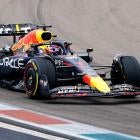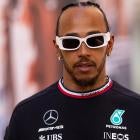
For the first time since the series raced at Caesars Palace for a short stint in the early 1980s, Formula 1 is returning to the streets of downtown Las Vegas in this year's greatly-anticipated Las Vegas Grand Prix. The Las Vegas GP marks the penultimate race of the 2023 season and F1's third Grand Prix in the United States, joining the Miami Grand Prix and United States Grand Prix as F1 continues to grow its market share in the US.
Compared to the Miami International Autodrome and the Circuit of the Americas, the major draw of the Las Vegas Grand Prix is the fact that F1 will be racing on a temporary street circuit set up in downtown Las Vegas, with the Las Vegas Strip Circuit incorporating many of the city's most iconic locations. Not only that, but the expectation is that this 3.8-mile circuit will produce very high speeds, comparable to some of the traditional fastest courses that the championship visits.
The start/finish line and Turns 1 through 4 are all set on new pavement over what was previously a parking lot before the first long straightaway going north on Koval Lane. Turns 5 and 6 will take the field east on Westchester Lane before Turns 7-9, which will go around the new Sphere before the course goes west down Sands Avenue for Turns 10 through 12.
The exit of Turn 12 gives way to the most glamorous part of the course, a long and fast straightaway down Las Vegas Boulevard with only a slight curve indicating Turn 13. The straightaway will be lined by many of Las Vegas' most iconic hotels and casinos, with the expectation of speeds approaching just over 200 mph down the 1.2-mile straight before a sharp left-hand corner to Turn 14, with Turns 15 and 16 leading back to East Harmon Avenue and a kink in Turn 17 leading back to the start/finish line.
🇺🇸 Viva Las Vegas! It's #LasVegasGP race week!
— Pirelli Motorsport (@pirellisport) November 13, 2023
🛞 Softest compounds in our range
↗️ Increased tyre pressures due to cooler temperatures
Read more ➡️ https://t.co/esvOKpEoQI pic.twitter.com/KoVACYDCta
As it stands, simulator work is each team and driver's lone means of getting a handle on what to expect on how the course will drive and how to optimize the setup of the car. But setting an expectation of what to do in Vegas goes beyond simply virtual reference, as the weather is expected to be a significant variable.
With a scheduled start time of 10 p.m. PT in late November, the expectation is that temperatures will be in the 40s, making for one of if not the coldest race in the history of F1 (The record belongs to the 1978 Canadian Grand Prix, which was run in 41 degree temperatures). The cold temperatures will be a particular challenge for tire maker Pirelli, as the compound used for F1 is engineered to generate grip at high temperatures.
Such conditions, for most sports organizations in the U.S., are to be expected even in areas such as Las Vegas. But for Formula 1, the expected weather presents something of an embarrassment and a massive oversight: Allegedly, F1 leadership didn't realize Las Vegas gets as cold as it does at nighttime in November.
"The one thing we hadn't considered initially but the tire company have dealt with is it gets very, very cold at night," Ross Brawn, the former motorsport managing director for F1, recently said. "So when the race is happening, which is Saturday night, it has been known to drop down to three or four degrees. So it can be really quite cold, and of course getting the cars to work in those temperatures can be a challenge."
The only two previous F1 races in Las Vegas were the 1981 and 1982 runnings of the Caesars Palace Grand Prix, which were won by Alan Jones and Michele Alboreto. Both races in the United States during the 2023 F1 season have been won by world champion Max Verstappen.














